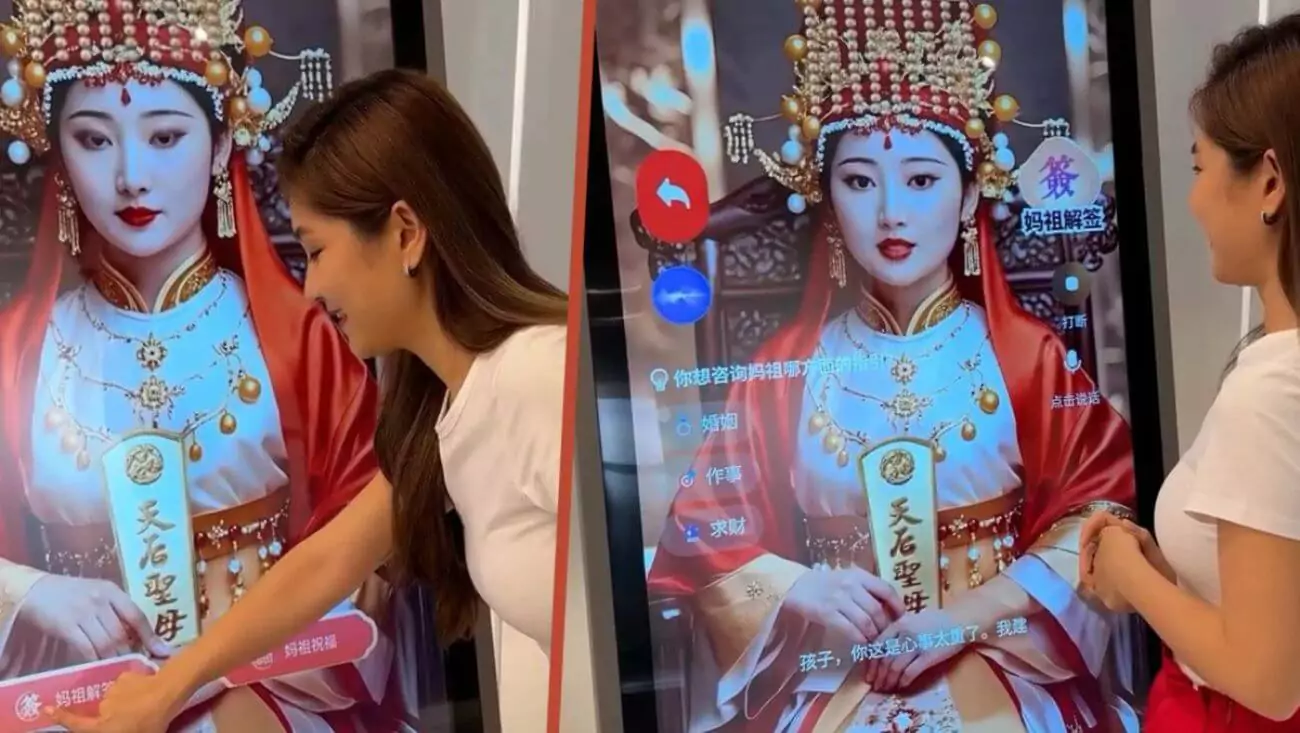April 28, 2025, Johor, Malaysia – Malaysia’s Tianhou Temple in Johor has made history by unveiling the world’s first AI-powered Mazu statue, a digital representation of the Chinese sea goddess that allows worshippers to interact and seek guidance through a screen. This innovative fusion of artificial intelligence and ancient tradition marks a significant step in modernizing religious practices, showcasing how technology can preserve cultural heritage while making it more accessible to a global audience.
The AI Mazu statue, displayed on a digital screen, depicts the deity as a serene figure in traditional Chinese attire, complete with a warm and tender voice. According to South China Morning Post, the statue was developed by Aimazin, a Malaysian tech firm known for its AI cloning services. Worshippers can engage with the digital Mazu by requesting blessings, interpreting fortune sticks, or seeking advice on personal concerns. In a demonstration, Aimazin’s founder, Shin Kong, asked the AI Mazu for luck in gaining unexpected fortune, to which the deity responded, “You would have better luck if you stay at home,” as reported by NewsBytes. This personalized interaction highlights the potential of AI to enhance user experiences, a trend also seen in Instagram’s recent updates that aim to improve digital engagement through features like locked Reels.
Mazu, revered as the goddess of the sea, holds a special place in Chinese culture, particularly among communities in Southeast Asia. Born in 960 as Lin Mo on Meizhou Island in China’s Fujian province, she is celebrated for sacrificing her life to save shipwreck victims, later ascending as a divine protector of seafarers. The Tianhou Temple’s initiative to integrate AI into worship reflects a broader movement to modernize cultural practices, similar to how Apple’s iOS updates have incorporated AI to enhance user accessibility on iPhones. By bringing Mazu into the digital realm, the temple ensures that her guidance remains relevant in a tech-driven world.
The AI Mazu offers a variety of interactive features that make spiritual guidance more accessible. Pragativadi notes that worshippers can ask the deity to interpret fortune sticks—a traditional practice in Chinese temples—or seek advice on personal matters. In one instance, an influencer struggling with sleeplessness approached the AI Mazu, who responded, “Drink some warm water before going to sleep,” addressing her as “my child.” This interaction resonated deeply with devotees, many of whom expressed their devotion through comments on social media, leaving praying hands emojis to request blessings. The use of AI in this context mirrors trends in digital content creation, where tools like video editing software enable users to craft meaningful experiences online.
Cultural Significance and Technological Innovation
Here’s a breakdown of the AI Mazu’s key features and impact:
- Digital display of Mazu in traditional Chinese attire with a soothing voice.
- Interactive features for interpreting fortune sticks and offering advice.
- Developed by Aimazin, a Malaysian firm specializing in AI cloning.
- Pioneering use of AI to modernize religious practices while preserving tradition.
The Tianhou Temple’s adoption of AI has sparked discussions about the role of technology in spirituality. Daily Express reports that the temple proudly claims this as “the first AI Mazu in the world,” emphasizing its commitment to innovation. This development comes at a time when AI is increasingly being integrated into various sectors, from education to entertainment, as seen in the evolution of streaming services that leverage AI to personalize user experiences. The AI Mazu statue represents a unique application of this technology, bridging the gap between ancient faith and modern accessibility.
While the AI Mazu has been largely well-received, it has also raised questions about the authenticity of digital worship. Some devotees may wonder whether a digital deity can truly embody the spiritual essence of Mazu, a figure deeply rooted in Chinese mythology. Others view the initiative as a progressive step, noting that it allows worshippers who cannot visit the temple in person to connect with the deity. This balance between tradition and innovation is a recurring challenge in the tech world, as seen in debates over digital safety practices and the ethical use of AI in user interactions. The Tianhou Temple’s approach offers a model for how technology can enhance accessibility without compromising cultural reverence.
The introduction of the AI Mazu statue could inspire other religious and cultural institutions to explore similar innovations. By leveraging AI, the temple not only preserves the legacy of Mazu but also makes her guidance available to a broader audience, including those who engage with spirituality through digital platforms. This development highlights the transformative potential of AI in cultural contexts, raising important questions about how technology can shape the future of faith. As AI continues to evolve, its role in preserving and modernizing traditions will likely become a focal point for communities worldwide.
What are your thoughts on using AI in religious practices? Does it enhance the spiritual experience, or does it challenge the authenticity of tradition? Share your perspectives in the comments, and let’s discuss how technology can continue to bridge the past and the future in meaningful ways.







